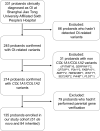Comparing Clinical and Genetic Characteristics of De Novo and Inherited COL1A1/COL1A2 Variants in a Large Chinese Cohort of Osteogenesis Imperfecta
- PMID: 35909573
- PMCID: PMC9329653
- DOI: 10.3389/fendo.2022.935905
Comparing Clinical and Genetic Characteristics of De Novo and Inherited COL1A1/COL1A2 Variants in a Large Chinese Cohort of Osteogenesis Imperfecta
Abstract
Purpose: Nearly 85%-90% of osteogenesis imperfecta (OI) cases are caused by autosome dominant mutations of COL1A1 and COL1A2 genes, of which de novo mutations cover a large proportion, whereas their characteristics remain to be elucidated. This study aims to compare the differences in clinical and genetic characteristics of de novo and inherited COL1A1/COL1A2 mutations of OI, assess the average paternal and maternal age at conception in de novo mutations, and research the rate of nonpenetrance in inherited mutations.
Materials and methods: A retrospective comparison between de novo and inherited mutations was performed among 135 OI probands with COL1A1/COL1A2 mutations. Mutational analyses of all probands and their family members were completed by Sanger sequencing. A new clinical scoring system was developed to assess the clinical severity of OI quantitatively.
Results: A total of 51 probands (37.78%) with de novo mutations and 84 probands (62.22%) with inherited mutations were grouped by the results of the parental gene verification. The proportion of clinical type III (P<0.001) and clinical scores (P<0.001) were significantly higher in de novo mutations. Missense mutations covered a slightly higher proportion of de novo COL1A1 mutations (46.34%) compared with inherited COL1A1 mutations (33.33%), however, lacking a significant difference (P=0.1923). The mean BMD Z/T-score at the lumbar spine in de novo mutations was -2.3 ± 1.5, lower than inherited mutations (-1.7 ± 1.8), but lacking statistical significance (P=0.0742). There was no significant difference between the two groups in OI-related phenotypes (like fracture frequency, blue sclera, and hearing loss) and biochemical indexes. In de novo mutations, the average paternal and maternal age at conception was 29.2 (P<0.05) and 26.8 (P<0.0001), respectively, which were significantly younger than the average gestational age of the population. Additionally, 98.04% of pedigrees (50/51) with de novo mutations were spontaneous conception. The rate of nonpenetrance of parents with pathogenic variants in the inherited mutation group was 25.64% (20/78).
Conclusions: Our data revealed that the proportion of clinical type III and clinical scores were significantly higher in de novo mutations than in inherited mutations, demonstrating that de novo mutations are more damaging because they have not undergone purifying selection.
Keywords: COL1A1; COL1A2; clinical scoring system; de novo; inherited; osteogenesis imperfecta.
Copyright © 2022 Mei, Zhang and Zhang.
Conflict of interest statement
The authors declare that the research was conducted in the absence of any commercial or financial relationships that could be construed as a potential conflict of interest.
Figures



Similar articles
-
Clinical characteristics and the identification of novel mutations of COL1A1 and COL1A2 in 61 Chinese patients with osteogenesis imperfecta.Mol Med Rep. 2016 Nov;14(5):4918-4926. doi: 10.3892/mmr.2016.5835. Epub 2016 Oct 12. Mol Med Rep. 2016. PMID: 27748872
-
De novo and inherited pathogenic variants in collagen-related osteogenesis imperfecta.Mol Genet Genomic Med. 2019 Mar;7(3):e559. doi: 10.1002/mgg3.559. Epub 2019 Jan 24. Mol Genet Genomic Med. 2019. PMID: 30675999 Free PMC article.
-
COL1A1 and COL1A2 Gene Variants Causing Osteogenesis Imperfecta in a Major Referral Center of India.Am J Med Genet A. 2025 Jul;197(7):e64023. doi: 10.1002/ajmg.a.64023. Epub 2025 Mar 6. Am J Med Genet A. 2025. PMID: 40047057
-
Rare splicing mutation in COL1A1 gene identified by whole exomes sequencing in a patient with osteogenesis imperfecta type I followed by prenatal diagnosis: A case report and review of the literature.Gene. 2020 May 30;741:144565. doi: 10.1016/j.gene.2020.144565. Epub 2020 Mar 10. Gene. 2020. PMID: 32165296
-
Lumbar disc herniation in osteogenesis imperfecta associated with a COL1A1 frameshift mutation: A case report and review.Medicine (Baltimore). 2025 Aug 1;104(31):e43451. doi: 10.1097/MD.0000000000043451. Medicine (Baltimore). 2025. PMID: 40760627 Free PMC article. Review.
Cited by
-
Classification of osteogenesis imperfecta: Importance for prophylaxis and genetic counseling.World J Clin Cases. 2023 Apr 26;11(12):2604-2620. doi: 10.12998/wjcc.v11.i12.2604. World J Clin Cases. 2023. PMID: 37214584 Free PMC article. Review.
-
Physiological and Transcriptomic Analyses Reveal the Effects of Carbon-Ion Beam on Taraxacum kok-saghyz Rodin Adventitious Buds.Int J Mol Sci. 2023 May 26;24(11):9287. doi: 10.3390/ijms24119287. Int J Mol Sci. 2023. PMID: 37298239 Free PMC article.
-
Molecular and Cellular Mechanisms of Osteoporosis.Int J Mol Sci. 2023 Oct 30;24(21):15772. doi: 10.3390/ijms242115772. Int J Mol Sci. 2023. PMID: 37958752 Free PMC article. Review.
-
A De novo Mutation in the COL1A1 Gene Leading to Severe Osteogenesis Imperfecta: Case Report and Review of the Literature.AJP Rep. 2024 Sep 12;14(3):e215-e223. doi: 10.1055/a-2388-3190. eCollection 2024 Jul. AJP Rep. 2024. PMID: 39268228 Free PMC article.
-
Does the c.-14C>T Mutation in the IFITM5 Gene Provide Identical Phenotypes for Osteogenesis Imperfecta Type V? Data from Russia and a Literature Review.Biomedicines. 2022 Sep 22;10(10):2363. doi: 10.3390/biomedicines10102363. Biomedicines. 2022. PMID: 36289625 Free PMC article.
References
-
- Marini JC, Forlino A, Cabral WA, Barnes AM, San Antonio JD, Milgrom S, et al. . Consortium for Osteogenesis Imperfecta Mutations in the Helical Domain of Type I Collagen: Regions Rich in Lethal Mutations Align With Collagen Binding Sites for Integrins and Proteoglycans. Hum Mutat (2007) 28(3):209–21. doi: 10.1002/humu.20429 - DOI - PMC - PubMed
MeSH terms
Substances
LinkOut - more resources
Full Text Sources
Medical
Miscellaneous

